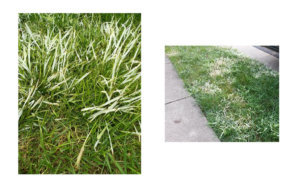What the heck is milky spore?
Stephen in Ellicott City writes: “When is the best time to apply milky spore to control Japanese beetle grubs in the lawn? How should it be applied, and how often should it be applied?”
Well, Steve, now through the end of September is the perfect time to apply milky spore powder, a naturally occurring soil organism that is deadly to Japanese beetle grubs. It’s the reason that Japanese beetles aren’t a serious problem in their native Japan. There aren’t a lot of lawns in that country to begin with, and many of the lawns that do exist are loaded with this natural control.
Apply milky spore powder according to the package directions. One application should control grubs for many years to come, as long as there are lots of grubs in your lawn for the powder to infect.
This is the time to get milky
Milky spore powder is a biological control — a naturally-occurring soil organism that is deadly to Japanese beetle grubs that ingest the spores in warm soil. Those points are important.
Even though milky spore is sold in the spring, but it does not work in the spring. To be effective, the soil has to be 70 degrees (as measured 4 inches deep), which is darn warm, and grubs must be actively feeding, which they only do in the late summer and fall.
Ah, but the soil is now at the perfect temperature and little baby grubs are now feeding on the roots of your lawn. So, go get ’em.
Life cycle of the Japanese beetle: Eat, mate, eat some more
As every gardener knows, Japanese beetles feed on plants such as roses and raspberries in the summer. The females then deposit their eggs in lawns — especially wet lawns that are cut too short.
The eggs hatch into nasty little grubs that proceed through several stages to become nasty big grubs that feed voraciously on the roots of your lawn. This is happening now and will continue through September, making this the perfect time to apply milky spore powder.
Every grub that ingests a spore of the biocontrol will not only die but become a living factory, making more milky spore.
Some lawns that were treated properly decades ago are still grub free after just that one application.
But ‘BTG’ may be even better!
There’s also a new nontoxic grub control in town: a new strain of the bio insecticide “Bt” known as BTG. The mail-order firm Gardens Alive sells it as “Grubhalt,” and it’s available at retail under other brand names.
Apply BTG now and it will kill any grubs feeding underground — without harming birds, bees, people, pets, frogs, toads or wombats. Similar to the other members of the “Bt family,” BTG is very specific: It only harms its target insects (in this case, beetles and weevils), and it’s very effective.
When lawns get spooky!
Ruth in Herndon and Jenn in Reston are among the many reporting what I’m going to call “ghost grass” — lawn grasses that have turned more white at the tips than the little bit of hair that’s left on top of my aging noggin’.

Several diseases of lawn grass will cause this discoloration, the most common of which is good old powdery mildew. Feel the tips of one of these discolored areas, and if a white powder comes off, you’ve got mildew, which is more common on Kentucky bluegrass.
Diseases like this are hard to avoid when lawns have to handle excessive amounts of water — especially lawns that drain poorly.
So, don’t reach for a fungicide if your grass goes ghostly. Instead, schedule a core aeration later this month or next to improve the drainage on your lawn. What was once white will again be green.
Mike McGrath was Editor-in-Chief of ORGANIC GARDENING magazine from 1990 through 1997. He has been the host of the nationally syndicated Public Radio show “You Bet Your Garden” since 1998 and Garden Editor for WTOP since 1999. Send him your garden or pest control questions at MikeMcG@PTD.net.







